Scunthorpe United
The club can trace its origins back to 1899 when Brumby Hall FC merged with a second (unknown) club and adopted the name Scunthorpe United. This followed the demise of Scunthorpe Town FC, who were formed around 1880. In 1910 another merger, this time with local rivals North Lindsey United, led to the creation of Scunthorpe & Lindsey United. The club played in local competition until 1912, when they were admitted to the Midland League. Thery became known as "The Nuts" or more usually, "The Knuts" after the Rev Cryspin T Rust described them as "tough nuts to crack" when presenting them with the Frodingham Charity Cup. Quite why a silent "K" was added is not recorded. This nickname was gradually replaced with the more familiar term, "The Iron."
In 1921, United made the first of many unsuccessful applications to join the Football League. They won the Midland championship in 1927 and again in 1939 and by the time war broke out, they were established as one of the stronger non-League sides.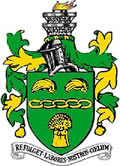
The first time that the club is recorded as wearing a crest was for the 1947-48 season, when the coat of arms of the Borough of Scunthorpe appeared. Worn on a light blue patch, the five chain links are a play on words on the abbreviation for Lincolnshire (Lincs - geddit?) and represent the five villages that were combined to form the borough in 1936. The wheatsheaf symbolises the agricultural origins of those villages and the two shells above the chain are Gryphaea, a fossil bivalve common in the local ironstone. The whole heraldic effort is sumrounted by a blast furnace.
In 1949 the Football League expanded with the addition of two clubs in each of the regional Third Divisions. In a series of eliminating ballots, Scunthorpe emerged triumphant after three rounds of voting and duly took their place in Division Three (North) for the 1950-1951 season. Almost 12,000 people turned up at the Old Show Ground to watch their first home game.
In 1958 United became the last club to win the Division Three (North) title and promotion to Division Two, the lower divisions being reorganised for the following season. During the close season the club dropped "and Lindsey” from their name to become, once again, Scunthorpe United. While playing in the Second Division the board decided on a radical change of kit (claret and blue being thought decidedly old fashioned) and in 1959 they turned out in white shirts and blue shorts with smart gold trim. In 1962 they led the division at one stage but fell 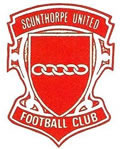 back to finish in fourth place, their highest ever placing, defeat in their last two games costing them promotion to the First Division.
back to finish in fourth place, their highest ever placing, defeat in their last two games costing them promotion to the First Division.
Decline followed with relegation in 1964 and 1968 taking the club back into the Fourth Division. In 1969 another radical change of kit came about to improve their sagging fortunes and for the next 13 seasons, the team played in all-red. Initially this strip was completely unadorned but in 1974 a new crest was introduced, which preserved the five chain links from the 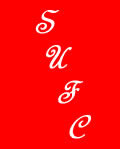 old town crest. It was at this time that Ray Clemence and Kevin Keegan emerged as youngsters in the Scunthorpe first team. They were, of course, sold on and enjoyed enormous success with Liverpool and England.
old town crest. It was at this time that Ray Clemence and Kevin Keegan emerged as youngsters in the Scunthorpe first team. They were, of course, sold on and enjoyed enormous success with Liverpool and England.
The crest disappeared after just one season and was replaced when Bukta became the club's kit provider in 1976 with a simple monogramme, much favoured at the time. This in turn made way for a rather more pedestrian, horizontal version on the 1979 Adidas strip, which was retained until 1982. On some occasions the team appeared in shirts without the monogramme.
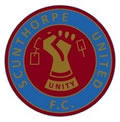 In 1982, United had to seek re-election, were promoted the following season and relegated the season after that. It was in 1984 that the club returned to the claret and blue colours worn until the early 1960s, but now in a variety of eye-catching combinations. To complement the team's new image, a smart new crest was commissioned. The links were now held firmly in a gold fist above the word "Unity." (The version worn on the team shirts reversed the blue and claret shown in the image on the left.)
In 1982, United had to seek re-election, were promoted the following season and relegated the season after that. It was in 1984 that the club returned to the claret and blue colours worn until the early 1960s, but now in a variety of eye-catching combinations. To complement the team's new image, a smart new crest was commissioned. The links were now held firmly in a gold fist above the word "Unity." (The version worn on the team shirts reversed the blue and claret shown in the image on the left.)
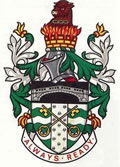 In 1988, the club quit their Old Showground home and moved out of Scunthorpe into the brand new purpose built Glanford Park stadium, built with financial support from Glanford Borough Council (whose crest appeared on the team's shirts between 1990 and 1994). Over the next five seasons the club reached the play-offs four times out of five but were unsuccessful each time. In 1994, following local government reorganisation, Scunthorpe and Glanford were reincorporated into Lincolnshire and this crest was dropped.
In 1988, the club quit their Old Showground home and moved out of Scunthorpe into the brand new purpose built Glanford Park stadium, built with financial support from Glanford Borough Council (whose crest appeared on the team's shirts between 1990 and 1994). Over the next five seasons the club reached the play-offs four times out of five but were unsuccessful each time. In 1994, following local government reorganisation, Scunthorpe and Glanford were reincorporated into Lincolnshire and this crest was dropped.
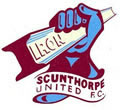 For the 1994-95 season a competition was held in local schools and colleges to design a new crest. The winner, designed in the finest traditions of Soviet Realism, depicted a fist clutching a girder, celebrating the town's long association with the iron and steel industry. This crest divides supporters, with traditionalists yearning for the reintroduction of the circular, 1982 version.
For the 1994-95 season a competition was held in local schools and colleges to design a new crest. The winner, designed in the finest traditions of Soviet Realism, depicted a fist clutching a girder, celebrating the town's long association with the iron and steel industry. This crest divides supporters, with traditionalists yearning for the reintroduction of the circular, 1982 version.
In 1999 The Iron finally won promotion to Nationwide Division Two (third tier) after beating Leyton Orient in the play-off final at Wembley. Disappointment followed and after only one season, they were relegated.
After narrowly avoiding relegation to the Conference in 2004, the Iron won automatic promotion in 2005 to Coca Cola League One (third tier) and rose to the Championship after winning the League One championship in 2007. Relegated at the end of the 2007-08 season, they bounced back in 2009 after beating Millwall in the play-off final only to be relegated again in 2011.
